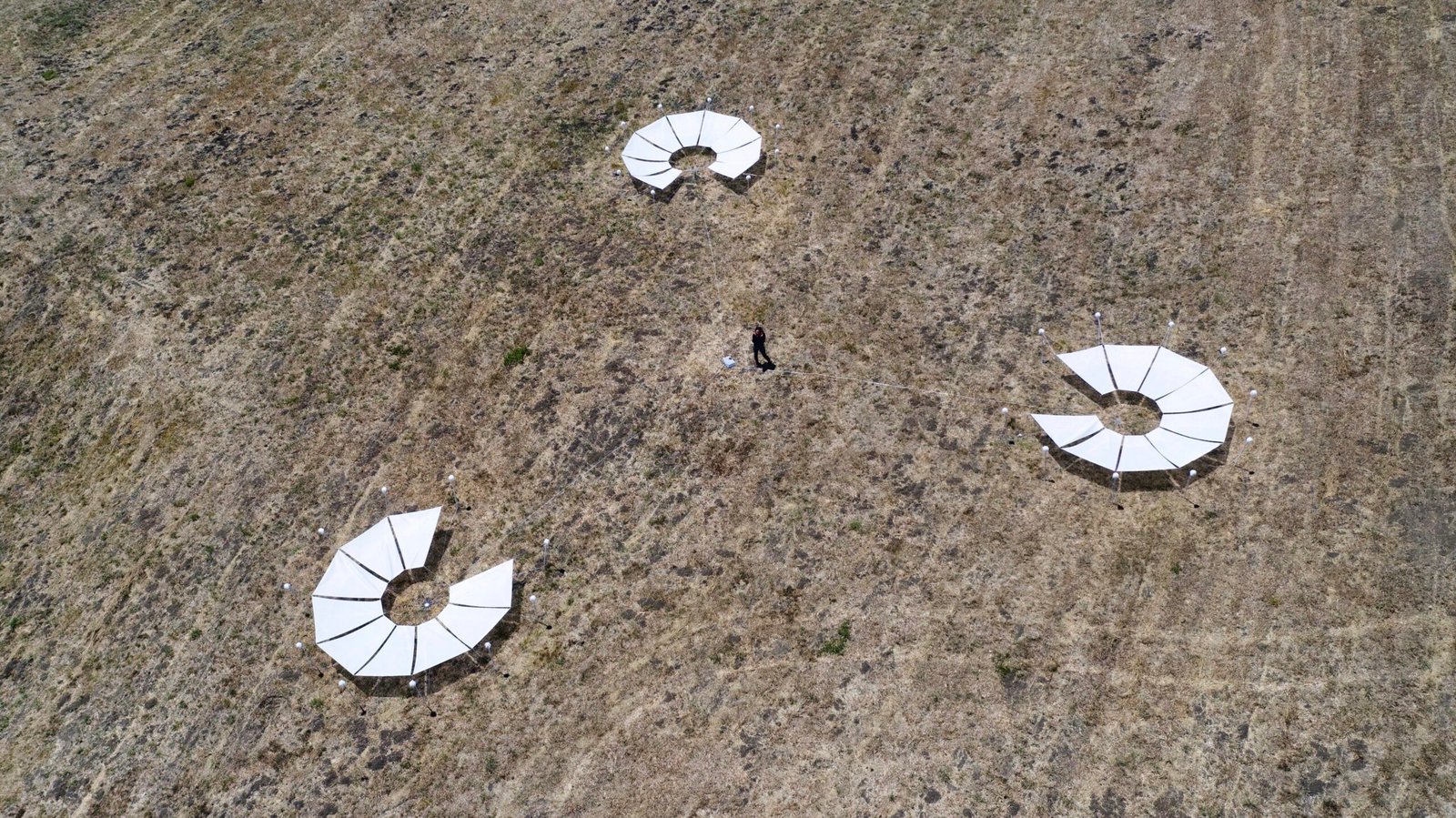We are music nerds at Everything Is Noise, each of us geeking out weekly, if not daily, about some obscure band or another, and this enthusiasm and passion is what has built and maintained this website. Some of us are musicians, but all of us have opinions on music regardless of our level of understanding music. I am not much of a musician, but I have become fascinated with how music works, or more specifically, how sound works. When I started learning about synthesizers, I took a step back from years of listening to music to appreciate that the building blocks of every sound, whether the strum of a guitar, the pop of a snare drum, the notes from a vocalist, or literally any other sound, musical or not, are just waves. Synthesizers allow you to shape and warp and modulate the wave length, shape, frequency, etc., of a relatively simple sound wave into potentially any sound you can imagine or wish to replicate. Thinking about sound this way can be overwhelming, but also kind of simplifies our music obsession into boiled-down clichés, like, ‘music is just wiggly air,’ or ‘Everything Is Noise.’
What I had not initially considered, and I imagine many people don’t, when thinking about the science of sound, is that just like the light spectrum, or our sense of smell, is that humans cannot hear every sound. There are frequencies that move around us all of the time that we are oblivious to. Think of a dog whistle (the object, not how public figures try to shine up their bigotry). The high pitched tone is unique in a way that dogs’ ears can hear it, while ours cannot. Dog whistles produce very high frequency sound waves. but there are also very low frequency sound waves that are outside of our hearing range, as well. This is called infrasound (again, think infrared, the light wave frequencies below our lowest level of perception), and it is produced by many things, slowly covering vast distances with its long and low waves.
This is where Brian House comes in. House is an artist and a professor, holding a PhD in computer music, utilizing interdisciplinary research and modern technology to create internationally renowned sound exhibits that have been displayed from MoMA to Los Angeles to Stockholm and beyond, gaining recognition from WIRED, The New York Times Magazine, The Guardian, and even a listing in TIME Magazine’s Best Inventions issue. He is an assistant professor of art at Amherst College and has been published in numerous scholarly and scientific journals. His recorded output, so far, includes improvised acoustic instruments merged with field recordings, but he is on the cusp of releasing a new project on November 7th, on Gruenrekorder, entitled Everyday Infrasound In An Uncertain World that documents recorded infrasound, using devices called macrophones to record and then speeding up the recordings by a factor of 60, allowing for these novel sounds to become audible. Here is an excerpt from the album:
‘There are two qualities of atmospheric infrasound that I find fascinating. The first is that infrasound is not only low; it is distant. That is, these long wavelengths (like a mile long) can travel vast distances through the atmosphere—even all the way around the globe. Knowing that, I feel that hearing these sounds changes my relationship to planet as a whole. I’m not imagining that I’m looking at the globe from outer space, in some disembodied way, I’m stretching out my sense of what’s around me where I stand. The second is that atmospheric infrasound comes from sources that are at the threshold between what is anthropogenic and what is geophysical. Changing ocean currents, wildfires, turbines, receding glaciers, industrial HVACs, superstorms … this is where climate change is literally happening. And these things make noise. So at the same time that we’ve changed our sensation of the planet, we’re also witnessing what is happening.’
”Macrophones’ is my term for the instruments I’ve put together that encompass a sensor and wind-mitigation manifold. There’s been a few iterations, some focused on portability, others on low-frequency fidelity, and others on the sculptural aspect. The primary form of this project is an installation artwork where visitors can listen to the infrasound happening right where they are. While I’m looking for the right exhibition opportunity for that, I wanted to release this album, because I just found the sounds so compelling’

‘…the Macrophones have a sample rate of 100 Hz as well as some additional filtering, so 40 hz is about the highest frequency they capture, which is audible sound, but just barely. Single digit frequencies are the sweet spot, and it goes down to a quarter of a Hz. Speeding the recordings up by a factor of 60 raises the pitch by ~6 octaves. And I should say that that ratio is a subjective choice. To me, it made sense because it maintained the weight of these sounds while raising them just enough to be audible.’
In a way, listening to this record is like listening to a noise album: you have to let the sounds happen and surprise you. With each new sound, one cannot help but wonder where it came from. For the time being, however, identifying the sources of each sound is elusive. ‘I can say that I’ve gained some intuition about which sounds are anthropogenic and which are geophysical,’ says House, ‘But much of what is there, I have no idea where it’s coming from, and the scientists I’ve worked with have not had answers either. Part of my motivation for getting this out there is to learn more about what I’m listening to.’ Knowing those sources could help provide greater context to Earth’s cycles, environmental degradation, and man’s indifference, but Brian says, ‘the sources don’t ultimately matter to me, it’s about the aesthetics of this usually inaudible world.’
Brian House has traveled far and wide with his macrophones, yet Everyday Infrasound was recorded in Amherst, Massachusetts. Besides being Brian’s home, he adds:
‘…it is purposefully not a charismatic space—we’re talking about suburban/rural Massachusetts. I’ve also recorded on Svalbard, and in old growth forests in Oregon, etc etc. But what is remarkable to me is that infrasound is everywhere. You don’t have to be in an exotic location to capture it. It’s all one atmosphere. So I think being in Amherst helps make that point. If I said I was in Antarctica or whatever, you’d receive it very differently, and honestly I am also very tired of Western sound artists extracting sound from the global ‘elsewhere’. Wherever we are, we’re listening to the planet.’
This album seems more like a science project than what people usually think of in terms of music. ‘I want this record to be understood as documentary as opposed to composition,’ Brian says. Yet it is in this document that the art arises. Like a photographer, Brian House is changing how we understand the world around us by exposing us to perspectives we haven’t considered about how we connect with our surroundings, but ultimately what he is doing isn’t solely about the science, either. ‘My macrophones are tuned for aesthetic purposes,’ he says, adding that geologists and vulcanologists use infrasound to learn more about the seismic and structural elements of the earth while the Comprehensive Test Bad Treaty Organization uses infrasound to monitor nuclear weapons testing.I know I am still sorting out how listening to these recordings make me feel, and I am certain their impact will linger, For Brian House, the impact is more defined and profound:
‘They’ve taught me to listen in a new way. That sounds cliché, but when you’re not sure what the sound is, or even what sound is, you have to follow the lead of signal and coax it into being on its own terms. I say that in regard to the mixing and mastering process. At the end, I feel like I have an intimate relationship with all these whistles and booms, whatever they are. So, now I’m walking around the world, and I know something more is there. Everywhere. Many sound artists treat listening as a kind of sacral act, and I get that, but I’ve always been more interested in the poetics and politics of everyday life. I’m a fan of Henri Lefebvre, for instance—also, after being out with NatGeo recording lions and being at a loss with those recordings, I decided to record urban rats instead (https://brianhouse.net/works/urban_intonation/), point being, it’s not about the elsewhere, it’s about the right here. If sound is special, it’s because it’s good at making our dynamic interdependencies accessible to the senses. You can’t get out of sound. The fact of planetary, atmospheric infrasound just makes that acute.’
All of this is truly one of the most amazing things I have run across in my decades of music obsessiveness, and I feel absolutely honored to get to cover such an innovative and unique artist. Brian House isn’t letting his curiosity slow down, either. ‘I’ve been working with the astrophysicist Jeff Hazboun, who’s part of the NANOGrav project that tracks cosmic gravitational waves via pulsar triangulation,‘ he says. ‘It’s wild. What I’m interested in there is the problem of ‘groundlessness’—that is, in a universe without absolute reference points, how do we situate ourselves and act with purpose? In many ways, it’s an extension of the thinking in the Macrophones project.’Be on the lookout for more from Brian House, whether it is musical or more of a documentary; he has a knack for finding the most interesting ways to capture and manipulate sound, and maybe through that, we can all come to appreciate sound and our home planet with more empathy and grace than we have ever given it. Like the David Attenborough of sound, Brian House is leaving an unparalleled love letter to planet earth in the liminal space where science and art collide, bridging the gap between what we can witness and what we stand to lose.Check out more from Brian on his website, Instagram, and Bandcamp pages!





